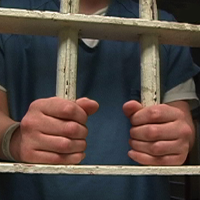Federal Judges Order Immediate Release of 10,000 Inmates from Overcrowded California Prisons

No self-respecting game show host would allow as many “final answers” as the federal courts have allowed California over how it would reduce the state’s overstuffed prison population.
On Thursday, Governor Jerry Brown received another, albeit more “final” sounding, demand for action than some of the others.
A three-judge panel tried to cut through years of courthouse negotiations, confrontation and frustration and ordered that state prisons (pdf) immediately prepare to release enough inmates on “good time credits” to relieve dangerous, inhumane overcrowding. They waived any local and state laws and regulations that stand in the way.
The two U.S. District Court judges and one appellate court justice demanded that the state “forthwith” reduce its prison population to 137.5% of the system’s design capability, which works out to freeing around 10,000 inmates.
And they weren’t nice about it. The judges noted the state’s “continued failure to cooperate with this Court.” They accused it of foot-dragging, backsliding and generally jerking the court around.
“More important than the length of the litigation, however, has been defendants’ conduct throughout. Defendants have continually equivocated regarding the facts and the law, and have consistently sought to delay the implementation of our Order.”
The state’s latest plea for time to pursue legislation to implement its own, admittedly inadequate plan—four and a half years after it was ordered to create one—was characterized by the judges as a “perpetuation of constitutional violations in the California prison system for the indefinite future.”
In fact, the two cases consolidated before the court date back to the 1990s. They deal, respectively, with the unconstitutional way prisons handle mentally ill inmates and medical care. Both, it was decided, were directly related to overcrowding.
In January, Governor Brown declared “the prison crisis” over and said the state would not submit any more plans or dump any more money down a “rat hole of incarceration.” His two-year-old realignment plan, which redirected certain low-level offenders to overcrowded local jails, helped reduce the prison population from 161,000 to around 120,000.
The court threatened to hold Brown and his administration in contempt, which brought them back to court. Now they have until the end of the year to reduce overcrowding further or free prisoners on a list of inmates considered unlikely to commit more crimes.
The Brown administration has given consideredation, but is reluctant, to release prisoners under the court’s good-behavior terms. It would prefer to whittle away at the prisons by taking steps like sending more inmates to firefighting camps, slowing the return of prisoners from private out-of-state prisons and leasing space in county jails.
The word “failure” is mentioned 15 times in the court’s 54-page decision, and not in a good way. The last sentence warns that future “failure” will not be tolerated and that the state will be found in contempt if it doesn’t take the necessary steps to hit the court’s numbers.
The state, however, can avoid a contempt citation if it “reports on such steps every two weeks” in lieu of actually taking them.
–Ken Broder
To Learn More:
Judges Tell California to Cut Prisoner Count by 10,000 (by Alex Dobuzinskis, Reuters)
Judges: Brown Must Fully Comply with Prison Order (by Don Thompson, Associated Press)
Federal Judges Order California to Free 9,600 Inmates (by Paige St. John, Los Angeles Times)
Judges Have a Few Choice Words for Governor Brown and the Prison Overcrowding Plan They Rejected (by Ken Broder, AllGov California)
Ralph Coleman et al v. Edmund G. Brown Jr. and Marciano Plata et al v. Edmund G. Brown Jr. (U.S. District Courts for the Eastern and Northern California Districts) (pdf)
- Top Stories
- Controversies
- Where is the Money Going?
- California and the Nation
- Appointments and Resignations
- Unusual News
- Latest News
- California Forbids U.S. Immigration Agents from Pretending to be Police
- California Lawmakers Urged to Strip “Self-Dealing” Tax Board of Its Duties
- Big Oil’s Grip on California
- Santa Cruz Police See Homeland Security Betrayal in Use of Gang Roundup as Cover for Immigration Raid
- Oil Companies Face Deadline to Stop Polluting California Groundwater





